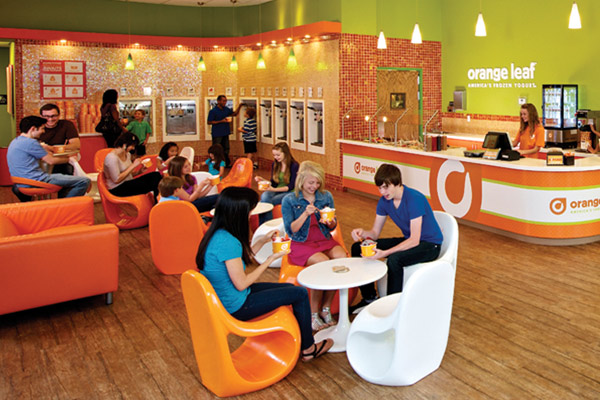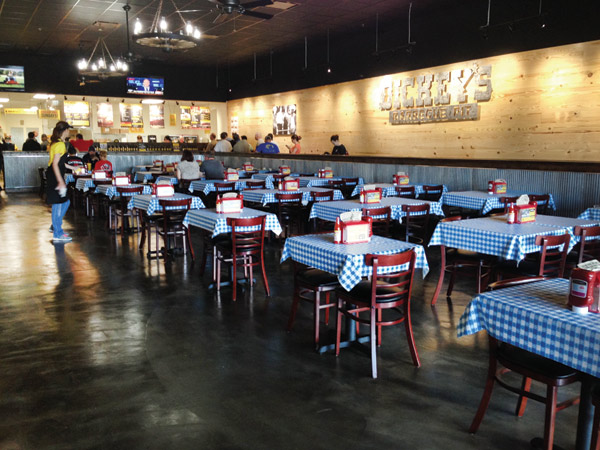100 new units a year? 30 percent growth? No problem. From site modeling to sourcing chairs, these chains have rapid expansion down pat.
Restaurant companies prepared to grow quickly typically have a pipeline that extends far into the future. Yet the success of their unit openings — whether franchised or company restaurants — depends on more than an impressive inventory. Experts say that company officials must also have a clear and comprehensive real estate strategy as well as the means to communicate it to franchisees, real estate brokers, general contractors and their own field personnel. "That's where really good site modeling comes into play," says Andy Simpson, a veteran development and design executive who now consults for Results Thru Strategy. "Companies good at site selection spend a lot of time developing it."
Site selection is, of course, just the tip of the fast-growth iceberg. Being adept at navigating the permitting process, keeping franchisees on track during the construction process, and ensuring that vendors come through with critical pre-opening supplies are also critical to ensuring speedy build-outs.
To learn more about the site modeling, real estate strategies and other tricks of companies on the fast track, rd+d talked with managers and executives from frozen yogurt chain Orange Leaf, Dickey's Barbecue Pit and Firebirds Wood Fired Grill — three operations that grew units by at least 30 percent in 2013, earning each a spot on Technomic Inc.'s "Fast 50 Growth Chains" list.
Orange Leaf
- HQ: Oklahoma City
- Concept: Self-serve frozen yogurt
- Technomic Fast 50 Rank: 5
- 2013 units/growth rate: 300 (15 company-owned)/38 percent
- 2014 units (projected): 400
- Project management software: Yes
- Average unit size: 1,200 to 2,200 square feet
- Average build-out: 45 to 60 days

"We have been adding 100 units a year, and currently have over 70 under construction," says Vincent Provenzano, franchise development manager for Orange Leaf, whose growth last year saw the company purchase 800 frozen yogurt machines.
Orange Leaf likes big cities and so far has opened franchised stores in Houston, New York City, Indianapolis and Chicago. Provenzano offers three reasons for the franchisor's ability to grow so quickly: a proprietary yogurt with 70 flavors; a supportive franchise system; and a site-modeling plan that enables it to select good sites within strategic markets.
The site-modeling plan includes two types of units — traditional stores and kiosks — the latter of which is a recently introduced lower-cost alternative. "Most of our [traditional] stores are in strip centers built within the last two years. We are not taking retired spaces, nor are we looking for conversions of other frozen yogurt shops. We're taking over a vanilla shell," explains Provenzano, adding that desirable co-tenants include Starbucks, Chipotle and Qdoba. The franchisor prefers that franchisees put their stores in malls in middle- to upper-income areas.
The new kiosk prototype targets "amusement parks, college campuses, malls and anywhere there is a captive audience," Provenzano says. Orange Leaf opened its first kiosk in a San Antonio mall.
Field service manager Trent DeSpain says current franchisees are a mix of mom-and-pops and multiunit operators. "We are starting to attract a lot of bigger franchisees," he says, referring to experienced franchisees capable of opening multiple stores. The cost to open a full-size unit ranges from $354,000 to $476,000 (including a $30,000 fee), according to DeSpain.
The officials say they have developed relationships with real estate brokers by attending conferences. Provenzano will introduce a broker to potential franchisees "at the point I know they are serious" — and if he knows a broker in that market. Otherwise, the franchisees are on their own.
Franchisees can choose their own general contractors to build their units. DeSpain gives GCs a construction manual that lists approved vendors and specs products. If franchisees do not know a GC, the franchisor recommends contractors it has worked with, Provenzano says.
Of course, construction can't begin without permits. DeSpain doesn't recommend hiring expediters to help speed up permitting. "Basically, your name gets moved up the list," he says, though he concedes that expediters are helpful when an opening is scheduled for a specific date.
The officials encourage franchisees "to lean heavily on us" during construction by, for example, calling Orange Leaf's opening store managers with questions and having GCs call the chain's construction managers. "We get these mom-and-pops, and it's their first time and they don't know what to expect," explains Provenzano. "They're nervous."
To keep things on schedule, moving quickly and smoothly, franchisees follow construction progress with Orange Leaf's project management software. It tells them week by week when to buy yogurt machines and POS systems, get their business licenses and so on. "We even make sure they go to the bank to get change for the registers," chuckles DeSpain. "We're basically holding hands."
Dickey's Barbecue Pit
- HQ: Dallas
- Concept: QSR barbecue
- Technomic Fast 50 Rank: 20
- 2013 units/growth rate: 370 (8 company-owned)/30 percent
- 2014 units (projected): 152 500
- Project management software: No
- Average unit size: 1,600 to 2,200 square feet
- Average build-out: 45 days

Dickey's Barbecue Pit grew throughout the 1980s by converting shuttered restaurants into barbecue joints. Today, its real estate strategy continues to evolve as the economy improves. "Our ideal site will always be a second generation," explains Trinity Hall, vice president of construction, "but as the economy picks up, they are getting few and far between. So we've shifted our mindset to a vanilla shell or a retail conversion."
This newer approach comes with a trade-off, of course. It now costs more to build a Dickey's, but the "hiccups" during construction tend to be fewer because "we know what we are getting," Hall says, adding that vanilla shells also trim construction times. Permits in hand, a franchisee can open a Dickey's, which typically run from 1,600 to 2,200 square feet, in about 45 days.
A low franchise fee ($15,000) and the cost to build (roughly $140,000) help drive growth. But an effective Dickey's site strategy, construction process and vendor research enable franchisees to open units quickly. While Hall notes that some vendors worry about being able to deliver as Dickey's opens stores so rapidly, Jeff Forrester, vice president of purchasing, who negotiates contracts with vendors, says most "love to see our growth."
Like other franchisors, Dickey's officials examine site demographics such as income levels, density and competition. Hall also learns how much and what types of signage a location allows. Armed with this knowledge, real estate brokers drive market areas looking for sites and reporting on competitors.
Permitting can be a challenge for a fast-growth concept that includes a smoker and barbecue oven. "When it's a difficult scope of work like an apartment building or a difficult state, we get an expediter," Hall says. In Virginia, for example, Dickey's has recently franchised 3 restaurants, and the permitting has taken 150 days, she says.
In less challenging locations, two Dickey's employees research local regulations and permit applications, sharing that information with local architects. Shortly after plan submission, franchisees visit the permitting offices to introduce themselves and talk about the concept. "We want them to say how excited Dickey's is to be in their city," says Hall, who meets new franchisees when they visit headquarters for training. Under normal circumstances, permitting usually takes about 45 days.
The chain does not use project management software, but once construction has started, a Dickey's auditor uses a camera phone to document the general contractor's progress and send the video images to Hall. "They do little snippets of film, front of house and back of house, and we compare that to a timeline so we know GCs are on schedule. You know, trust but verify," she adds.
Meanwhile, Hall's six-person project-management team handles questions from franchisees. What's the most frequent? "Owner-operators want to know when the new-store opener can come to their site," she says. "They're really excited at that point."
Firebirds Wood Fired Grill
- HQ: Charlotte, N.C.
- Concept: Polished casual
- Technomic Fast 50 Rank: 32
- 2013 units/2013 growth rate: 29 (all company-owned)/30 percent
- 2014 units (projected): 8
- Project management software: Yes
- Average unit size: 6,800 square feet
- Average unit build-out: 135 days

Like other restaurant CEOs, Firebirds' Mark Eason begins each new eatery by penciling the numbers. "Construction cost, building cost and all those factors that go into the ROI," he says. But unlike most operators of small chains, Eason has a site-analytics firm helping him hit that percentage (somewhere around 28 percent).
To be sure, having sophisticated site data is a lot better than guessing. Yet Eason and his team opened the first 17 Firebirds the old-fashioned way: driving markets and looking for movie theaters, malls, office buildings, interstates and the like. They also depended on research done by large upscale chains, figuring their sites must be decent.
"Angelo Gordon wanted us to get a little more detailed, so we hired a site-analytics firm to help pinpoint locations," Eason recalls, referencing the private equity firm that purchased the company three years ago. "But we still haven't nailed [sales projections] 100 percent."
Current data has either projected sales too high or too low for the 14 restaurants opened since the private equity firm bought the company. So seven months ago management decided to update the model by including guest survey data. Eason expected the new site model to be ready by late spring.
Meanwhile, management plans on opening eight new restaurants this year and nine in 2015. Most of the new builds will be outside of the company's mid-Atlantic home base. Ohio, for instance, is a new market for the chain.
Gerald Pulsinelli, vice president of development, says today it takes only 135 days from the start of construction to open a new 6,800-square-foot Firebirds — that's 15 days fewer than in the past. The reduced timeline is due largely, he adds, to a site investigation report (or SIR) done by one of two architectural firms the company hires. The report includes "parameters" that management requires for each new site.
These new-store parameters have been carefully documented since the first Firebirds opened 14 years ago. "We kept building on the parameters, and they just became a checklist you either add to or take away from. All the tools are there with the dates and everything," Eason explains. "We put the best practices together from our previous lives," adds Pulsinelli, who grew up in the restaurant business and has since worked for several chains, including Morton's.
Management, which uses two general contractors, divides the 135-day construction process into thirds. "First, you've got your first round of inspections, the walls are up with wiring and the ceilings are roughed in. In the second third, there are MEP inspections and the kitchen equipment is put in," Pulsinelli explains. "The final third is the finishing work."
Receiving the right materials from vendors, on time, is critical to maintaining schedules, and that's all about the submittals, Eason says. Vendors send images and samples to Firebirds' architects and its director of construction, who make sure the colors and finishes match the spec. And, despite its small size, the company attempts to buy directly from manufacturers to save both time and money. Eason recently discovered a chair maker in Ohio, for example, not far from where the company was opening a restaurant. "We bypass the vendor now," he says, "and buy our chairs directly from that manufacturer."



